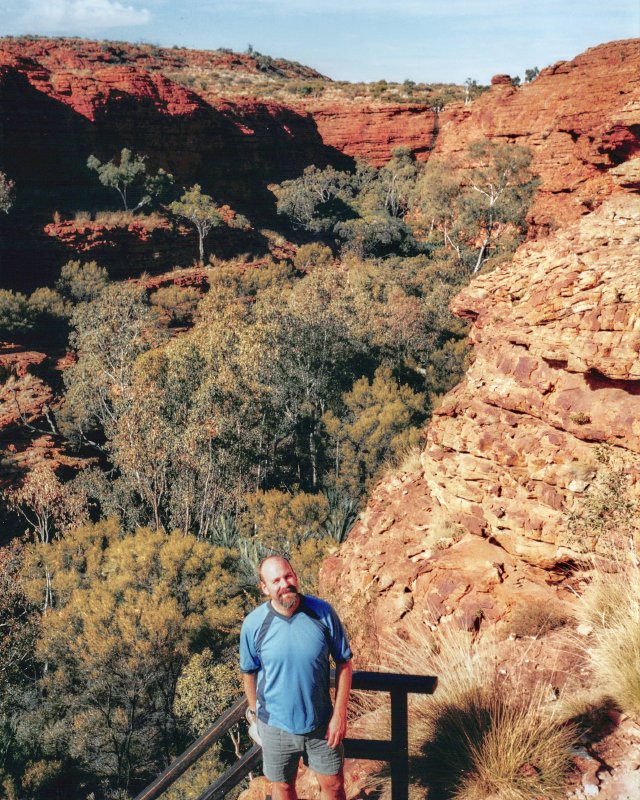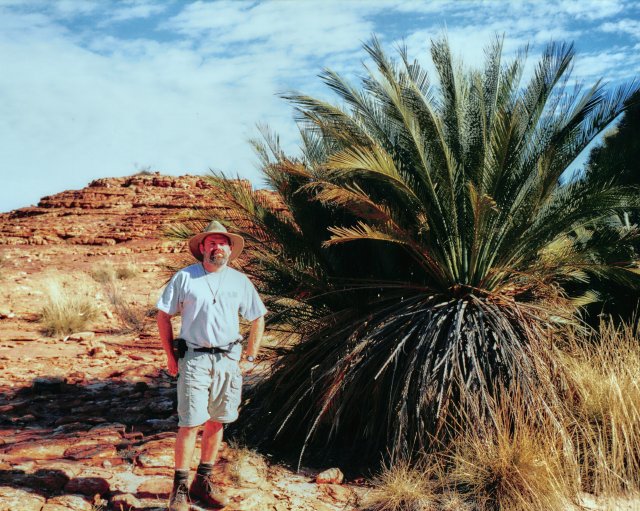Kings Canyon to Redbank Gorge, Northern Territory
We finally get off the beaten track in Central Australia. While it isn't quite an American- and German-free day (my measure of off the beaten track), it comes close after we finish up our bushwalk in Kings Canyon and drive around the Merininee loop to the West MacDonnell mountains. Along the way, we stop at a stunning comet crater and finish the day with a gorge walk where we watch the rock wallabies play on the cliffs.
American Teens Must Die
Being waken up at 4:30am by two teenage girls in the shower might be someone's fantasy of a good morning... but it was certainly not mine.
The American tour group had pulled up yesterday afternoon just an hour after we set up camp, and proceeded to be, well rude Americans, walking from their bunkhouse-style rooms through our camp, carrying on until evening time, then running the washer and dryer about 20 meters from our tent until 11pm. We shared the toilet and laundry facilities with them--they were in a concrete block structure without a ceiling. There's just metal roofing over it, and the walls stop about a foot below the roof. Thus, without really trying, you can hear someone fart in the loo at 50 meters.
I was not amused with the late night laundry ruckus as I tried to get to bed--and not more than five hours later, hearing Allison and Caitlin in the shower gossiping on and on was not making me a happy camper. I stewed in my sleeping bag for a good half hour while they showered before throwing in the towel, getting my glasses on, and banging on their shower stalls in the ladies room, reminding them that it's 5am in the morning and to please shut the fuck up in my best American authoritative voice. They did... for the twenty minutes it took to finish their showers.
But that wasn't all... soon, the other two dozen started trickling out, dragging their noisy wheeled luggage through the campground at not quite 6am... which they did for the next half hour, in pairs and triplets, every few minutes. And chatting. Endlessly chatting. They just didn't get it that tent walls aren't quite as solid as concrete blocks.
Sigh. I wasn't going to get back to sleep, I'd been awake an hour and a half already. So I got up and made some tea at 6:15, watched the wheelie bag parade... and pretended I was Australian for a bit. Hopefully they wouldn't figure it was me that shouted at them in the toilets; who knows, maybe they have maniacal boyfriends or somesuch. Good thing I got up, their diesel coach had arrived and noisily idled for a good twenty minutes while they loaded up the bus.
And then the day got much better.
Off to Kings Canyon
Chris had slept through all of that somehow; with the kids gone we had a pleasant breakfast which the miner birds and pigeons tried to share. We even had a butcherbird eyeing our cereal. Butcherbirds have a wonderful melodious voice, with many varied songs. Apparently my twitcher book says that suburbanites love them for this, and try and attract butcherbirds to their gardens. Their eating habits aren't so polite, though--they earn their name by grabbing lizards, insects, and other critters against rocks and sticks, then eating the pieces that fly off. I can't imagine it's pretty.
After brekkie, we drove the 10km and did the walk around Kings Canyon, along with about 200 other people. Surprisingly, they weren't that much of a bother: they kept to their own groups, and there was quite a lot to see. It's a 7 kilometer hike that packs a lot: you climb onto a canyon rim, then wander through a maze of eroded sandstone domes, with occasional overlooks across the canyon. The canyon isn't that deep, but the cliffs are quite sheer, maybe 100 meters tall to the scree below. In the bottom of the canyon, there's water, which supports a whole community of rare plants like cycads and ferns that you wouldn't expect to find in the middle of the desert. It was really good.
From Kings Canyon, we took a 4WD loop around west and north, heading back towards Alice Springs. It's a long loop at about 200 kilometers of gravel roads, but it avoids a 500 kilometer backtrack were we to stick to the sealed roads. It also passes by a feature I've wanted to see: the Gosse Bluff impact crater.
The Crater of a Comet
Gosse Bluff is all that remains of a massive comet impact 140 million years ago. It's a circular ring of low mountains a few hundred meters high, that rises abruptly out of a gently sloping plain. The circle is about 5 kilometers across, and in the middle is a flat, level floor. You can drive into the circle through a gap in one of the walls.
What makes Gosse Bluff all the more impressive is that it's only the center part of the impact--the real crater walls were about 25 kilometers across, and have long since eroded away. You can imagine how it formed if you visualize what a stone does when it hits water. You get an outwardly expanding circular ripple, with a central spurt of water. Gosse Bluff is just the deep, buried rocks that were liquefied upon impact and rebounded straight up.
It was magnificent. And it took a long time to figure out what caused it, because unlike meteors, which are dense iron-nickel boulders, comets are low density ice and gas. It's one of the most geologically studied parts of Australia, and it wasn't until the early 1970's that geologists finally came to consensus on how it was formed.
Redbank Gorge and Camp
I wanted to drive up Tyler's Pass to get a good lookout over Gosse Bluff--and wasn't disappointed at the view. Chris looked at the map, though, and saw that we could keep going to Redbank Gorge in the West McDonnell ranges, rather than follow our original plan to head to Palm Valley. After reading the description of the two campsites in Lonely Planet, it was easy for me to decide:
Redbank Gorge: shady campsites with a nice sense a privacy, well set up campground, down a 4WD track with light traffic, two campgrounds Palm Valley: small campground popular with safari tour operators from Alice Springs, down a popular 4WD track. OK, we headed to Redbank Gorge. I might just go ballistic if I see another obnoxious American tourist. We drove there, set up camp, and decided to wrap up the day with a hike to the gorge, about a five minute drive north.
This gorge was great--it was all red sandstone that got narrow and narrower until finally it got to about 4 meters wide--with a waterhole right across it! The trick is you're supposed to use an air mattress to paddle up to the narrow bits. Chris considered using one of the inner tubes that someone had left there, but one toe in the freezing water told him he wasn't going there! After a few pictures, we started walking back to the car.
I was admiring the landscape of ghost gums, cypress, and red sandstone when I saw something move--and it moved up. It was a rock wallaby! Yay! I've heard they live around here, but didn't expect to see one! Wallabies are like small kangaroos, and these live on the cliffs and rockfaces here in Central Australia. There were quite a few around, a good dozen or so. You just had to be still for a minute or two, then they unfreeze themselves and start hopping merrily up and down the rocks. They were very cool. I got close enough to one to take a picture.
Our campsite, though, didn't last. There were bees. Annoying bees. Not flies, which is what you expect in Australia, but bees. And the free gas BBQ didn't work. Fortunately, there's only one other occupied campsite, so we went around to six other campsites before finding a BBQ that would light. Now we're cooking with gas! We moved our tent over, had a not-so-great noodle bowl (Thai Laksa) that was more salt and MSG than anything else, and went to bed.
Looks like it's going to be a cold one tonight too, our handy dandy thermometer is reading 8.1C now, at 8:18pm.
Weird Wildlife Sighting
It's a two-fer day!
First, we saw Spinifex Pigeon on the Kings Canyon walk. These really are pigeons, but the coolest ones you'll see, with a little pointy crest that sticks straight up on their head, and beautiful brown and black stripes on the wings.
On our walk through Redbank Gorge, we saw Black-footed Rock Wallaby (Petrogale lateralis) hopping around the cliffs just before sunset. They were a bit timid, but if you whistle low and mournfully they'll let you get somewhat close, within 10 meters. We'll see how the pictures come out.







